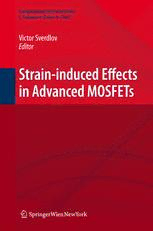
Strain-Induced Effects in Advanced MOSFETs PDF
Preview Strain-Induced Effects in Advanced MOSFETs
W Computational Microelectronics Edited by Siegfried Selberherr Technical University Vienna Vienna, Austria For further volumes: www.springer.com/series/1263 Viktor Sverdlov Strain-Induced Effects in Advanced MOSFETs SpringerWienNewYork Viktor Sverdlov Technical University Vienna Institute for Microelectronics Gusshausstrasse 27-29 1040Vienna Austria [email protected] Thisworkissubjecttocopyright. Allrightsarereserved,whetherthewholeorpartofthematerialisconcerned,specificallythose oftranslation,reprinting,re-useofillustrations,broadcasting,reproductionbyphotocopying machinesorsimilarmeans,andstorageindatabanks. ProductLiability:Thepublishercangivenoguaranteeforalltheinformationcontainedin thisbook.Theuseofregisterednames,trademarks,etc.inthispublicationdoesnotimply, even in theabsence ofaspecificstatement, that suchnames are exempt fromthe relevant protectivelawsandregulationsandthereforefreeforgeneraluse. © 2011Springer-Verlag/Wien PrintedinGermany SpringerWienNewYorkisapartofSpringerScience+BusinessMedia springer.at Cover:WMXDesignGmbH,Heidelberg,Germany Typesetting:SPi, Chennai, India Printedonacid-freeandchlorine-freebleachedpaper SPIN:80018573 With101 Figures LibraryofCongressControlNumber:2010938373 ISBN978-3-7091-0381-4 e-ISBN978-3-7091-0382-1 DOI10.1007/978-3-7091-0382-1 SpringerWienNewYork To Alexandra,Karin, Ludmila,&Nikolai • Preface Strain is the main tool to boost current and enhance performance of advanced silicon-basedmetal-oxide-semiconductorfield-effecttransistors(MOSFETs).Mod- elingandunderstandingofstraineffectsonbandstructureandmobilityhasbecome the important task of modern simulation tools used to design ultra-scaled MOS- FETs.Thisbookfocusesonmodernmodelingapproachesandmethodsdescribing strain in silicon. Contrary to the valence band, strain-induced conduction band modifications have received substantially less attention. Peculiarities of subband structuresin thin semiconductorfilms under stress are investigatedin detail using numerical pseudopotential calculations as well as a k(cid:2)p theory, which includes the two lowest conduction bands. Implementation of strain in transport modeling for modern microelectronicsdesign tools is overviewed. Application ranges from devicemodelingtoappliedmathematicsandsoftwaredevelopment. Thebookisbasedonmyresearchandpartlyonmycourseoflecturesgivenfor theMaster’sandPhDstudentsinelectricalengineering,microelectronics,physics, and applied mathematicsat the Institute for Microelectronics,Technische Univer- sita¨tWien.ThisbookwouldnothavebeenwrittenwithoutthesupportoftheInsti- tuteforMicroelectronicsanditsDirectorUniv.Prof.Dipl.-Ing.Dr.techn.E.Langer. I would like to thank Univ.Prof.Dipl.-Ing. Dr.techn. T. Grasser, Univ.Prof. Dipl.- Ing. Dr.techn. H. Kosina, and Univ.Prof.Dipl.-Ing.Dr.techn. Dr.h.c. S. Selberherr fortheiroverwhelmingencouragement,support,andhelpinwritingthebook. Iwouldliketoacknowledgethecontributionstothebookmadebymycolleagues and co-authors: O. Baumgartner, J. Cervenka, S. Dhar, T. Grasser, A. Gehring, G. Karlowatz, M. Karner, H. Kosina, K. Likharev, M. Nedjalkov, M. Pourfath, F. Schanovsky, S. Selberherr, Z. Stanojevic, M. Vasicek, E. Ungersboeck, and T. Windbacher. I also would like to thank H. Ceric, R. Entner, O. Ertl, W. Goes, P. Hehenberger, R. Heinzl, S. Holzer, A. Makarov, G. Milovanovich, N. Neo- phytou, R. Orio, V. Palankovski, K. Rupp, P. Schwaha, I. Starkov, F. Stimpfl, O.Triebl,S.Tyaginov,S.Vitanov,P.Wagner,S.Wagner,J.Weinbub,andW.Wess- ner for many fruitful and stimulating discussions and C. Haslinger, E. Haslinger, M.Katterbauer,and R. Winklerfor technicalsupportin preparingthe manuscript. Specialthanksgoto O.Baumgartner,M.Nedjalkov,andK. Sitzwohl,whokindly agreedtotaketheheavydutyofproof-readingandimprovingthemanuscript. vii viii Preface Thenewscientificresultsdescribedinthelastsectionsofthebookwouldhave been impossible to obtain without financial support from the Austrian Science Fund FWF through the projects P-17285-N02 and P-19997-N14, from the Euro- peanResearchCouncilthroughthegrant247056MOSILSPIN,fromtheEuropean Commission, project SINANO IST-50684, and from the European Science Foun- dation EUROCORES Program FoNE funded by the Austrian Science Fund FWF (projectI79-N16),CNR,EPSRCandtheECSixthFrameworkProgram. Vienna ViktorSverdlov July2010 Contents 1 Introduction................................................................... 1 2 Scaling,PowerConsumption,andMobilityEnhancementTechniques 5 2.1 PowerScaling .......................................................... 5 2.2 StrainEngineering...................................................... 6 2.3 GlobalStrainTechniquesandSubstrateEngineering ................ 8 2.4 LocalStressTechniques ............................................... 10 2.5 AdvancedStressTechniques........................................... 12 2.6 HybridOrientationTechnologyandAlternativeChannelMaterials. 14 References...................................................................... 16 3 StrainandStress.............................................................. 23 3.1 StrainDefinition........................................................ 23 3.2 Stress.................................................................... 25 3.3 Relation Between Strain and Stress Tensor inSiliconandGermanium............................................. 27 3.4 StrainandStressTensors:Examples.................................. 28 3.4.1 UniformAll-AroundCompression.......................... 28 3.4.2 BiaxialStrainResultingFromEpitaxialGrowth............ 29 3.4.3 UniaxialStress................................................ 32 References...................................................................... 34 4 BasicPropertiesoftheSiliconLattice...................................... 35 4.1 CrystalStructureofSiliconandGermanium ......................... 35 4.2 ReciprocalLatticeandFirstBrillouinZone .......................... 39 4.3 ParticleinaPeriodicPotential......................................... 41 References...................................................................... 44 5 BandStructureofRelaxedSilicon.......................................... 45 5.1 ConductionandValenceBands........................................ 45 5.2 First-PrincipleBandStructureCalculations .......................... 46 5.3 PseudopotentialBandStructureCalculations......................... 49 5.4 Semi-EmpiricalTightBindingMethod ............................... 56 ix x Contents 5.5 ComparisonBetweenDifferentNumericalMethods................. 58 References...................................................................... 61 6 PerturbativeMethodsforBandStructureCalculationsinSilicon...... 63 6.1 Thek(cid:2)pMethodforaNon-DegenerateBand......................... 63 6.2 EffectiveMassTheoryforNon-DegenerateBands................... 64 6.2.1 ElectronEffectiveMassinRelaxedSilicon................. 66 6.2.2 ApproximationsfortheConductionBand DispersionatHigherEnergies............................... 67 6.3 ValenceBand........................................................... 70 6.3.1 Spin–OrbitCouplingintheValenceBand .................. 72 6.3.2 DispersionoftheValenceBandinSilicon .................. 75 6.3.3 LuttingerParameters ......................................... 76 References...................................................................... 80 7 StrainEffectsontheSiliconCrystalStructure............................ 83 7.1 Strain-InducedSymmetryReductionofSiliconCrystalLattice..... 83 7.1.1 Oh Symmetry................................................. 83 7.1.2 D4h Symmetry................................................ 84 7.1.3 D3d Symmetry ............................................... 85 7.1.4 D2h Symmetry................................................ 85 7.1.5 C2hSymmetry................................................ 86 7.2 InternalStrainParameter............................................... 86 7.3 StrainandSymmetryoftheBrillouinZone........................... 88 References...................................................................... 90 8 StrainEffectsontheSiliconBandStructure.............................. 91 8.1 LinearDeformationPotentialTheory................................. 91 8.1.1 ConductionBand ............................................. 91 8.1.2 ValenceBand ................................................. 93 8.1.3 Stress-InducedBandSplittingoftheValenceBands ....... 94 8.2 InclusionofStrainintoPerturbativeBandStructureCalculations... 97 8.3 EmpiricalPseudopotentialMethodwithStrain.......................102 References......................................................................103 9 StrainEffectsontheConductionBandofSilicon ........................105 9.1 LimitationoftheEffectiveMassApproximation fortheConductionBandofSilicon ...................................105 9.2 TheTwo-Bandk(cid:2)pModel .............................................107 9.2.1 ValleyShiftDuetoShearStrain.............................108 9.2.2 Stress-DependentTransversalEffectiveMasses............111 9.2.3 DependenceonStrainoftheLongitudinal EffectiveMass................................................112 9.2.4 StressandNon-Parabolicity..................................115
